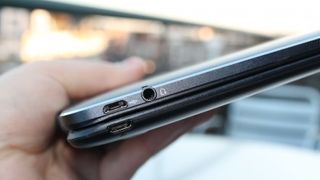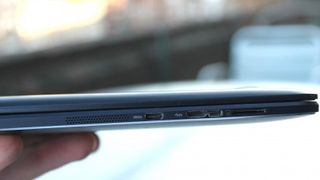Why you can trust TechRadar
Like the Surface 3 and Venue 11 Pro 7000, the Asus Transformer Book T100 Chi stuffs its internals behind the display, which makes it slightly top heavy but never feels in danger of tipping over. With both parts combined, the Chi T100 measures just 8mm thick (versus the Surface 3's 8.7mm) and weighs 570 grams (versus the Surface 3's 798 grams).
On the underside of the T100 Chi's base are four rubber feet that keep it from slipping when placed on a surface. The device isn't hugely configurable, with only two versions available that let you choose between 32GB or 64GB of internal eMMC flash storage. Even at 64GB, around a third is swallowed up once you count the operating system, so you'll have to make the most of its expandable micro-SD card slot if you want to store a lot of data locally.

Here is the Transformer Book T100 Chi's spec sheet that was provided to TechRadar:
Spec sheet
- Intel Bay Trail-T Quad Core 1.46GHz (Turbo Boost to 3.9GHz)
- Operating System: Windows 8.1
- Onboard memory: 2GB (1.89GB usable)
- Display: 10.1-inch 16:10 Full-HD (1920 x 1200) LED Backlight Glare Panel
- Graphics: Integrated Intel HD Graphics
- Storage: 64GB
- Card Reader: Card reader (Micro SD)
- Camera: Front 2MP and Rear 5MP
- Networking: Integrated 802.11a/b/g/n
- Built-in Bluetooth V4.0+HS
- Interface: 1 x Combo audio jack / 1 x micro SUB / 1 x HDMI / 1 x SD card reader / 1 x AC adapter plug / 1 x volume up/down
- Battery: 30Whrs
- Dimensions: Tablet - 265 x 174.5 x 7.2 / Dock - 265 x 174.5 x 13.2
- Weight: Tablet - 0.57kg (with Polymer Battery) / 0.51kg
One of the main annoyances of the T100 Chi is that the keyboard base charges separately to the tablet part. Both have a single micro-USB port on the side, which means you'll need two separate cables to charge both at the same time. If you just have the one, it'll mean swapping it when the battery in either runs low.
The Bluetooth keyboard is turned on using a switch on the top-right side of the base, which can be flicked off to conserve battery. Pressing a key will lead to a brief delay before any action takes place on the screen, which is a small yet annoying gripe that could've been avoided if there was a direct connection between the two parts.

In terms of ports, you'll find just enough connectivity options to get by. Along the edge of the base you'll find one micro-USB 2.0 port, one USB 3.0 micro-B port, micro-HDMI, a micro SD slot that supports cards up to 128GB and a 3.5mm audio jack.

Apple's new MacBook has attracted criticism for having a single USB Type-C port, and the Chi T100 runs into a similar, if less pronounced problem. The T100 Chi similarly lacks full-size USB ports, but the inclusion of a USB 3.0 micro-B port along the tablet's right-hand edge can be used to connect a hub for standard USB peripherals while at the same time using the micro-USB 2.0 port on the left-hand side of the tablet to keep it charged.
Unlike the MacBook, the T100 Chi is unable to use its USB port to output to a display; instead, Asus has provided a micro-HDMI port on the right-hand side. Though the setup means you're going to have to carry around more cables than you might like, on the plus side you're not forced to lug a proprietary charging brick around.


